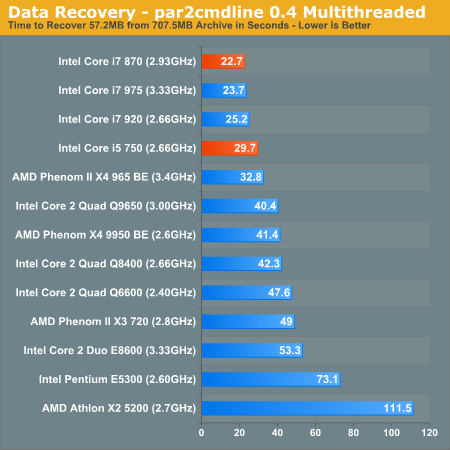Intel's Core i7 870 & i5 750, Lynnfield: Harder, Better, Faster Stronger
by Anand Lal Shimpi on September 8, 2009 12:00 AM EST- Posted in
- CPUs
PAR2 Multithreaded Archive Recovery Performance
Par2 is an application used for reconstructing downloaded archives. It can generate parity data from a given archive and later use it to recover the archive
Chuchusoft took the source code of par2cmdline 0.4 and parallelized it using Intel’s Threading Building Blocks 2.1. The result is a version of par2cmdline that can spawn multiple threads to repair par2 archives. For this test we took a 708MB archive, corrupted nearly 60MB of it, and used the multithreaded par2cmdline to recover it. The scores reported are the repair and recover time in seconds.

Faster than AMD? Check. Slower than the Core i7 920? Check. Costs under $200? Check. It's a shame that Intel didn't enable Hyper Threading on the Core i5 750, otherwise it would've really ruined most of the LGA-1366 lineup. The Core i7 860 is probably the best of both worlds unfortunately they are very hard to come by at this point.
The Core i7 870 is actually faster than the i7 975 here. I'll chalk that up to DDR3-1333 with some aggressive turboing.
WinRAR - Archive Creation
Our WinRAR test simply takes 300MB of files and compresses them into a single RAR archive using the application's default settings. We're not doing anything exotic here, just looking at the impact of CPU performance on creating an archive:

Large file compression is very well threaded and thus we see a real difference in performance between the HT enabled i7 920 and the i5 750 without Hyper Threading. The i7 870 however is within 5% of the i7 975, at 56% of the cost.










343 Comments
View All Comments
strikeback03 - Tuesday, September 8, 2009 - link
How would you have graphics then? You would be limited to the 4xPCIe off the P55 on motherboards which support it, as there are no integrated graphics (yet)MX5RX7 - Tuesday, September 8, 2009 - link
I'm not sure that CPU/GPU integration is a good thing, from a consumer standpoint. At least in the short term.For example, in the article you mention how the majority of modern games are GPU, not CPU limited. The current model allows us to purchase a very capable processor and pair it with a very capable GPU. Then, when the ultra competitive GPU market has provided us with a choice of parts that easily eclipse the performance of the previous generation, we either swap graphics cards for the newer model, or purchase a second now cheaper identical card and (hopefully) double our game performance with SLI or Crossfire. All without having to upgrade the rest of the platform.
With the current model, a new graphics API requires a new graphics card. With Larrabee, it might very well require a whole new platform.
Ben90 - Tuesday, September 8, 2009 - link
Yea, im really excited for Larrabee, who knows if it will be good or not... but with intel kicking ass in everything else, it will at least be interestingWith overclocking performance seemingly being limited by the PCI-E controller, it seems like an unlocked 1156 would be pretty sweet
All in all i gotta admit i was kinda bitter with this whole 1156 thing because i jumped on the 1336 bandwagon and it seemed that Intel was mostly just jacking off with the new socket... but this processor seems to bring a lot more innovation than i expected (just not in raw performance, still great performance though)
chizow - Tuesday, September 8, 2009 - link
Was worried no one was going to properly address one of the main differences between P55 and X58, thanks for giving it a dedicated comparison. Although I would've like to have seen more games tested, it clearly indicates PCIE bandwidth becoming an issue with current generation GPUs. This will only get worst with the impending launch of RV8x0 and GT300.Anand Lal Shimpi - Tuesday, September 8, 2009 - link
PCIe bandwidth on Lynnfield is only an issue with two GPUs, with one you get the same 16 lanes as you would on X58 or AMD 790FX.If I had more time I would've done more games, I just wanted to focus on those that I knew scaled the best to see what the worst case scenario would be for Lynnfield.
In the end 2 GPUs are passable (although not always ideal on Lynnfield), but 4 GPUs are out of the question.
Take care,
Anand
JumpingJack - Thursday, September 10, 2009 - link
Anand, a few other sites have attempted SLI/Xfire work ... on in particular shows 4 GPUs having no impact at all on gaming performance in general -- well, 3 or 4 FPS, but nothing more than a few percentages over norm.Could your configuration with beta or just bad first release drivers be an issue?
Jack
JonnyDough - Tuesday, September 8, 2009 - link
Would it be possible to incorporate two GPU controllers onto a die instead of one or is that what they'll be doing with future procs? I would think that two controllers with a communication hub might supply the needed bandwidth of x16 + x16.Comdrpopnfresh - Tuesday, September 8, 2009 - link
with two gpu's being passable- do you foresee that applying to both two independent gpus, as well as the single dual-card gpus?Ryan Smith - Tuesday, September 8, 2009 - link
Yes. The only difference between the two is where the PCIe bridge chip is. In the former it's on the mobo, in the latter it's on the card itself.Eeqmcsq - Tuesday, September 8, 2009 - link
Talk about bringing a bazooka to a knife fight. AMD better be throwing all their innovation ideas and the kitchen sink into Bulldozer, because Intel is thoroughly out-innovating AMD right now.